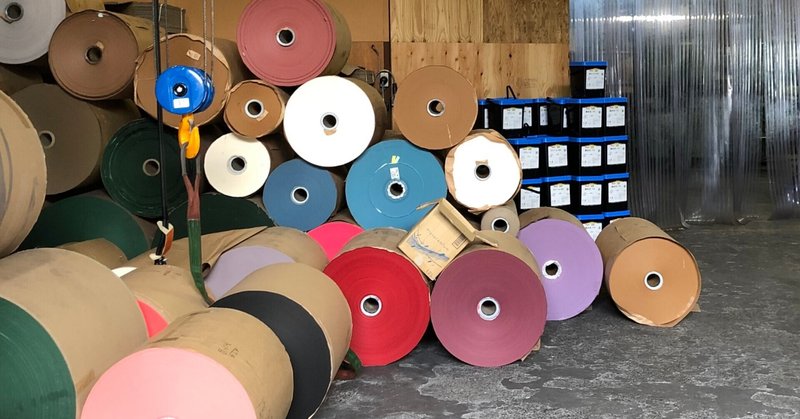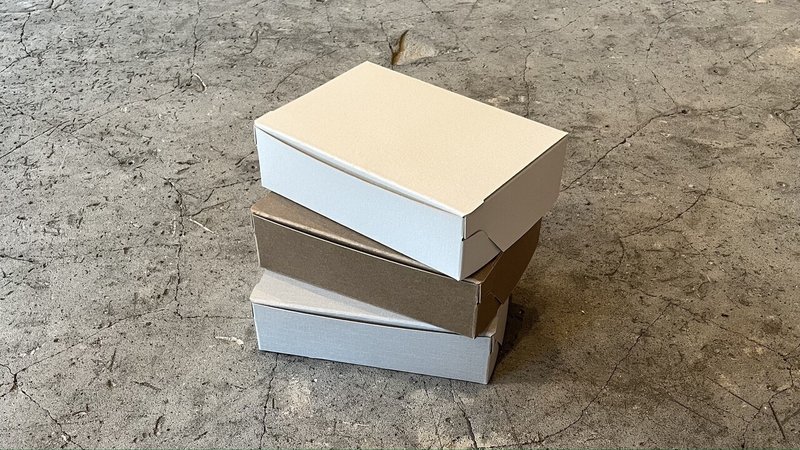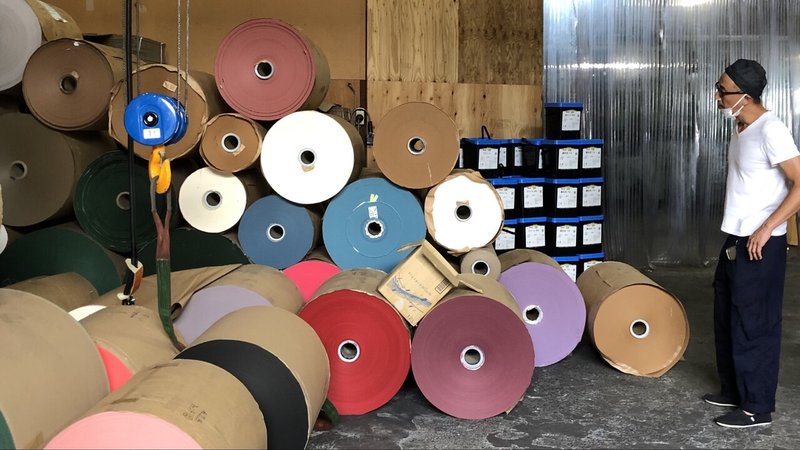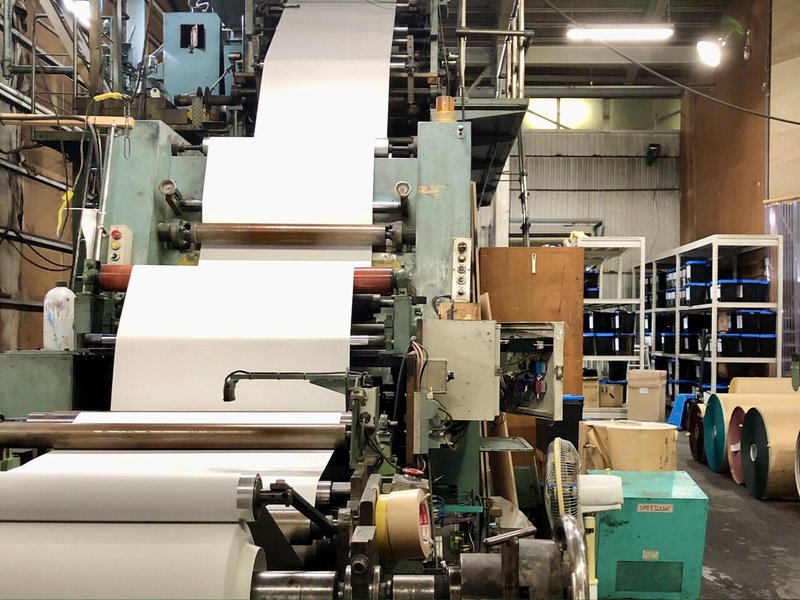
第4回 さて、何作る? The 4th Now, what to make?
竹内紙器製作所と堀木は〈星野株式会社(以下ホシノ)〉というものづくりの心強いパートナーを得たわけですが、それですぐにタケノマル発進! となったわけではありません。一方で場所を作りながら、もう一方でモノを作りながら、作っている当人たちにもその具体的なカタチはまだ見えていません。それでも手を動かすことをやめず、グルグルと思考を巡らせてしまうのが職人というもの。
Takeuchi Shiki Seisakusho and Horiki have gained an encouraging manufacturing partner, Hoshino Corporation (Hoshino). However, that did not mean that Takeuchi Shiki Seisakusho and Horiki immediately launched Takenomaru! While building a place on the one hand, and making things on the other, even those who are making things do not yet have a concrete form in sight. Even so, the craftsmen never stop moving their hands and thinking in circles.
堀木がディレクションに携わったホシノのカタログは、これまでの顧客にはもちろん新しい取引先にも好意的に受け入れてもらえ、それはホシノにとってもひとつの手応えとなりました。堀木と組むことで資材を作って売るという商売にとどまらないものづくりができるのではないか。そんな思いを新たにしたホシノはちょうどパッケージに力を入れていこうとしていた時期でもあり、いろいろ提案してもらえないだろうかと堀木に相談しました。堀木は、チップボールとTD(※1)、それぞれ 350g/㎡(※2) と 650g/㎡ があればある程度の要望に対応できるという話をしました。その話の中で、ホシノ向きかどうかは別として、堀木は自分好みの紙も提案はしていました。ただ、紙の仕入れはロットとの戦いでもあるので、なんでもかんでも仕入れるというわけにはいきません。チップボールとTDがうまく軌道にのって、もういくつか種類を増やそうかという流れになればいいなと堀木は考えていました。
※1. どちらも紙の種類の名称。製紙会社によっては呼称が変わることもあります。
※2. g/㎡は「坪量」の単位で"グラム毎平方メートル"と読みます。坪量とはある紙を"1m×1m"の寸法にしたときの1枚あたりの重さ。一般的に厚さの目安として用いられています。
Hoshino's catalogs, which Horiki was involved in directing, were favorably received by existing customers as well as new clients, and this was a positive response for Hoshino. Hoshino felt that by partnering with Horiki, it would be possible to go beyond the business of making and selling materials. Hoshino was just about to focus on packaging, and asked Horiki if he could make a variety of proposals. Horiki told Hoshino that chipboard and TD (*1), 350g/m2 (*2) and 650g/m2 respectively, would be sufficient to meet certain requirements. In the course of this discussion, Horiki also proposed paper that he preferred, whether it was suitable for Hoshino or not. However, purchasing paper is also a battle against lot size, so we cannot just stock anything and everything. Horiki hoped that Chipboard and TD would take off well, and that he would be able to add a few more types to the lineup.
*1. Both are names of paper types. The name may change depending on the paper manufacturer.
*2. g/㎡ is a unit of tsubo (basis weight) and is read as "grams per square meter". The basis weight is the weight of one sheet of paper when it is made into a 1m x 1m sheet. It is generally used as a standard for thickness.

ホシノの強みはいくつかありますが、そのひとつは紙をロールで仕入れられることでしょうか。製品としてできあがった紙には1枚ずつ断裁された「平版」と、ロール状に巻かれた「巻取」の2種類があります。ロールで仕入れるメリットは、ひとつのサイズから効率よく必要なサイズにカットできることはもちろん、平版で仕入れられない紙もロールでなら仕入れられる場合もあるということです。一方で、ロールで仕入れるためには必要なサイズにカットするための断裁機が必要であることはもちろん、購入力、販売力、保管スペースといった会社力も必要になります。これだけの条件を備えているホシノと出会えたことは堀木にとって幸運なことでした。幸運には幸運でお返しをしなければ。
One of Hoshino's several strengths is its ability to purchase paper in rolls. There are two types of finished paper products: "flat plate," which is cut one sheet at a time, and "rolls," which are rolled. The advantage of purchasing paper in rolls is that it is possible to efficiently cut paper from one size to the required size and that paper that cannot be purchased in flat sheets can sometimes be purchased in rolls. On the other hand, purchasing paper in rolls requires not only a cutting machine to cut the paper into the required size, but also company resources such as purchasing power, sales power, and storage space. It was fortunate for Horiki to have met Hoshino, which had all of these requirements. We must repay our good fortune with good fortune.

そもそもの始まりはやはりストレージでした。ストレージは段ボールでできているのですが、ここで段ボールについて少し説明を。
段ボールまたはダンボールは、断面の波型が階段状に見えることからそう命名(※3)されました。平らな板紙(ライナー)と波状に加工された板紙(中芯)が貼り合わされています。板紙とは厚紙のことで、ボール紙と呼ばれているもののことです。ボール紙は英語の「board paper」に由来しています。
ライナーの厚さは4〜7の数字で表記され、紙質は古紙の含有率で区別され、D(ジュートライナー、古紙含有率100%)、C(ジュートライナー、古紙含有率90%以上)、K(クラフトライナー、古紙含有率50%以上)の3種類に大別されます。厚さと含有量の組み合わせではC5、K5などが一般的です。
中芯は波(フルート)の高さによってA(5mm)、B(3mm)、W(A+B、8mm)、E(1.5mm)、F(1.1mm)、G(0.9mm)、5号(2.5mm)の7種類があり、一般的な段ボール箱に使われているのはAフルートです。フルートは英語で「丸溝ひだ」の意味。近世ヨーロッパの貴族などの衣装に見られるひだ襟のイメージでしょうか。
※3. 現在のレンゴー株式会社の創業者、井上貞治郎 a.k.a.日本の段ボールの父 によって命名されました。
It all started with storage. Storage is made of corrugated cardboard, but let me explain a little about corrugated cardboard.
Corrugated fiberboard was named so because its corrugated cross section looks like a staircase (*3).It consists of flat paperboard (liner) and corrugated paperboard (core) laminated together.Paperboard is thick paper, which is called cardboard. The word "cardboard" is derived from the English "board paper".
Liner thickness is indicated by a number from 4 to 7, and paper quality is distinguished by the content of recovered paper, which is broadly classified into three types: D (jute liner, 100% recovered paper content), C (jute liner, 90% or more recovered paper content), and K (kraft liner, 50% or more recovered paper content). The most common combinations of thickness and content are C5 and K5.
There are seven types of medium core according to wave (flute) height: A (5mm), B (3mm), W (A+B, 8mm), E (1.5mm), F (1.1mm), G (0.9mm), and No. 5 (2.5mm), and A-flute is used for general corrugated boxes. Flute means "round-groove folds" in English. It may be an image of the folded collars seen on the costumes of aristocrats and other aristocrats in early modern Europe.
※3. Named by Teijiro Inoue, a.k.a. the father of Japanese corrugated packaging, the founder of today's Rengo Co.
構想の初期段階でストレージの基本色はグレーでした。地券紙(※4)を片面ダンボールに合紙して作ろうとしましたが、強度の問題で諦めたという経緯があったのです。ならばストレージをオリジナルのカラーで作ることはできないだろうか。できないことはないかもしれないが、段ボールをオリジナルカラーで作るのはロットが大きすぎて現実的ではない。そんなジレンマを抱えていた堀木は、ホシノがライナーをロールで仕入れることができると知るや、着色することはできないかと相談を持ちかけました。コルビュジエが色彩設計したカラーパレットから選んだ薄い白とグレーを、一般的なライナーによくあるクラフト紙に塗るというのが堀木のアイデアでした。しかしインクは調合できても、塗ったときにクラフトの地の色が透けて出てしまうということでインク屋が音をあげました。塗りサンプルを見ると確かに地が透けていましたが、そこには計算していないが故の魅力がありました。いいじゃん、これでいこう! ということになりましたがその矢先、幅が1,300mmの印刷機(※5)でないとストレージに必要なサイズを印刷できないという、致命的な問題が発覚してしまいます。誰も先に確認していなかったんですね(笑)。いったん計画を見直すことになりましたが、職人はただでは転びません。じゃあ、板紙でやってみよう! ということに。
※4. 古紙を原料として製紙され、硬質で薄く耐折性に劣り裂けやすい。レポート用紙の裏などに使われている、あのグレーの台紙です。「地券」は土地の持主を特定し所有権を認めるために明治政府が発行した証明書のことで、その地券に使われていたことからそう呼ばれているようです。地券発行にまつわる裏話が国税庁のホームページで紹介されていて興味深い内容でした。https://www.nta.go.jp/about/organization/ntc/sozei/network/152.htm
※5. ホシノの輪転機は800mm巾。
In the early stages of conception, the basic color of storage was gray. We tried to make it by laminating chikenshi (*4) with cardboard on one side, but gave up due to strength issues. Then, could we make the storage in the original color? It might be possible, but making corrugated board in original colors is not realistic because the lot size is too large. Horiki was faced with such a dilemma, and when he learned that Hoshino could purchase liners in rolls, he asked if it would be possible to color them. Horiki's idea was to apply light whites and grays selected from the color palette designed by Le Corbusier to the kraft paper commonly used for ordinary liners.However, the ink manufacturer was concerned that even though the ink could be mixed, the colors of the kraft background would show through when the ink was applied.The ink samples showed that the base color did indeed show through, but there was a charm to it that we had not calculated. We decided, "That's good, let's go with that! But just as we were about to do so, we discovered a fatal problem: we could not print the required size for storage unless we used a 1,300 mm wide printing press (*5). No one had checked ahead of time.lol Once the plan was revised, however, craftsmen don't just roll over. So, let's try paperboard! That's what we decided to do.
※4. made from recycled paper, rigid, thin, poor in folding resistance, and easily torn.It is that gray backing paper used for the back of report papers. The name "chiken" comes from the fact that it was used to identify the owner of land and was issued by the Meiji government to recognize ownership of the land. The story behind the issuance of chiken is introduced on the National Tax Agency's website, which is interesting.https://www.nta.go.jp/about/organization/ntc/sozei/network/152.htm
※5. Hoshino's rotary press is 800 mm wide.

チップボールとTDの、各350g/㎡と650g/㎡を、それぞれ白とグレーで塗って(あと無色もあり)、ワックス加工したものと撥水加工したもののサンプルを作ることになりました。ワックス加工はスムーズに進行したのですが、撥水加工で暗礁に乗り上げます。チップボール350g/㎡の白がどうしてもうまく撥水してくれませんでした。撥水機のスピードを遅くしたり、紙の表裏を変えてみたり、マシンを調整したり改造してみたり、ホシノの敬司さんもあの手この手で試行錯誤してくれたのですが効果なし。また、650g/㎡では比較的うまくいっているということがますます謎を深めました。いずれにしても、撥水剤がうまく浸透していないのではないかということにあたりをつけ、撥水剤の濃度を上げるとともに、白インクを薄めるために混ぜていた水をメジューム(※6)に変更してインクの粘度を低下させないようにしたのですが、これもうまくいきませんでした。LINEには連日のように敬司さんから失敗の報告が届きました。いつもはユーモアたっぷりにスタンプや絵文字が送られてくるのですが「次は絞りローラーを弱めて再度挑戦」というメッセージには悲壮感が漂っていました。最終的にはこれが功を奏し、撥水剤を必要な量だけ染み込ませることに成功しました。乾燥に通常よりも時間がかかるようになったため、その分作業スピードは落ちましたがひとまず一件落着となり、敬司さんのLINEにも絵文字が復活しました。
※6. 顔料を抜いた無色のインキのこと。英語で書くと「medium」です。「Mサイズ」という場合などに使われる中間という意味のほか、媒体、媒介物という意味があります。ちなみに複数形にすると「media」です。情報を媒介する、メディアです。言葉っておもしろいですね。
We decided to make samples of chipboard and TD, each 350 g/m2 and 650 g/m2, painted white and gray respectively (and also colorless), waxed and water-repellent. The waxing process proceeded smoothly, but the water-repellent process ran into a snag. The white chipboard 350 g/m2 did not repel water well. Mr. Keiji of Hoshino tried to slow down the speed of the water repellent machine, changed the front and back of the paper, adjusted and modified the machine, and tried all sorts of other things, but to no avail. Also, the fact that it worked relatively well at 650 g/m2 became more and more of a mystery. In any case, Hoshino suspected that the water repellent was not penetrating well, so we increased the concentration of the water repellent and changed the water mixed to dilute the white ink to medium (*6) to prevent the viscosity of the ink from decreasing, but this also did not work. Reports of failure arrived daily from Mr. Keiji on LINE. He usually sent humorous stamps and emojis, but his message, "Next time, weaken the aperture roller and try again," was filled with a sense of sadness. In the end, this worked, and we succeeded in soaking up the required amount of water repellent. The drying process took longer than usual, which slowed down the speed of the work, but the case was settled for the time being, and the emojis were back on Mr. Keiji's LINE.
※6. Colorless ink without pigment.

そうこうしている間にストレージには新しいサイズである"ストレージLP・ハーフ"ができあがっていました。その前に「"ストレージLP"って何?」という疑問に答えるほうが先でしょうか。それはまた、次の機会に。
In the meantime, a new storage size, "Storage LP Half," has been created. I guess I should first answer the question, "What is "Storage LP"? I'll leave that for the next time.

この記事が気に入ったらサポートをしてみませんか?
